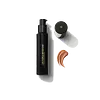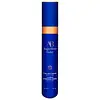Victoria Beckham Beauty Victoria Beckham By Augustinus Bader Cell Rejuvenating Priming Moisturizer Versus Augustinus Bader The Light Cream
What's inside
What's inside
 Key Ingredients
Key Ingredients

 Benefits
Benefits

 Concerns
Concerns

 Ingredients Side-by-side
Ingredients Side-by-side

Water
Skin ConditioningGlycerin
HumectantTriethylhexanoin
MaskingEthylhexyl Polyhydroxystearate
EmollientIsostearyl Isostearate
EmollientSaccharomyces/Xylinum/Black Tea Ferment
Skin Conditioning1,2-Hexanediol
Skin ConditioningOctyldodecyl Myristate
EmollientPersea Gratissima Oil
Skin ConditioningSilica
AbrasiveSodium Acrylates Copolymer
Potassium Cetyl Phosphate
EmulsifyingMica
Cosmetic ColorantSodium Hyaluronate
HumectantSynthetic Fluorphlogopite
Lecithin
EmollientSodium Polyacrylate
AbsorbentPanthenol
Skin ConditioningPropylene Glycol
HumectantCaprylic/Capric Triglyceride
MaskingCitric Acid
BufferingCetyl Palmitate
EmollientPapain
Skin ConditioningO-Cymen-5-Ol
AntimicrobialPolysorbate 80
EmulsifyingSorbitan Stearate
EmulsifyingTocopherol
AntioxidantSodium Hydroxide
BufferingCaprylyl Glycol
EmollientCarbomer
Emulsion StabilisingN-Hydroxysuccinimide
Skin ConditioningChlorella Vulgaris Extract
Skin ConditioningSodium Benzoate
MaskingTin Oxide
AbrasiveAlgin
MaskingPotassium Sorbate
PreservativeHydrogenated Lecithin
EmulsifyingPalmitoyl Tetrapeptide-10
Skin ConditioningCI 77891
Cosmetic ColorantIron Oxides
CI 77489
Cosmetic ColorantCI 77491
Cosmetic ColorantCI 77499
Cosmetic ColorantWater, Glycerin, Triethylhexanoin, Ethylhexyl Polyhydroxystearate, Isostearyl Isostearate, Saccharomyces/Xylinum/Black Tea Ferment, 1,2-Hexanediol, Octyldodecyl Myristate, Persea Gratissima Oil, Silica, Sodium Acrylates Copolymer, Potassium Cetyl Phosphate, Mica, Sodium Hyaluronate, Synthetic Fluorphlogopite, Lecithin, Sodium Polyacrylate, Panthenol, Propylene Glycol, Caprylic/Capric Triglyceride, Citric Acid, Cetyl Palmitate, Papain, O-Cymen-5-Ol, Polysorbate 80, Sorbitan Stearate, Tocopherol, Sodium Hydroxide, Caprylyl Glycol, Carbomer, N-Hydroxysuccinimide, Chlorella Vulgaris Extract, Sodium Benzoate, Tin Oxide, Algin, Potassium Sorbate, Hydrogenated Lecithin, Palmitoyl Tetrapeptide-10, CI 77891, Iron Oxides, CI 77489, CI 77491, CI 77499
Water
Skin ConditioningGlycerin
HumectantMaris Aqua
HumectantSodium Acrylates Copolymer
1,2-Hexanediol
Skin ConditioningCellulose
AbsorbentMicrocrystalline Cellulose
AbsorbentPropanediol
SolventGlyceryl Glucoside
HumectantEthylhexyl Polyhydroxystearate
EmollientOryza Sativa Bran Oil
EmollientSqualane
EmollientLecithin
EmollientSodium Phytate
Citric Acid
BufferingSodium Hyaluronate
HumectantO-Cymen-5-Ol
AntimicrobialHydrolyzed Rice Protein
Skin ConditioningMaltodextrin
AbsorbentSodium Citrate
BufferingSodium Hydroxide
BufferingHydrolyzed Adansonia Digitata Extract
EmollientPorphyridium Cruentum Extract
Skin ConditioningPhragmites Communis Extract
Skin ConditioningPoria Cocos Extract
Skin ConditioningBackhousia Citriodora Leaf Extract
AstringentSodium Benzoate
MaskingAloe Barbadensis Leaf Juice Powder
Skin ConditioningCamellia Sinensis Leaf Extract
AntimicrobialHydrogenated Lecithin
EmulsifyingTocopheryl Acetate
AntioxidantXanthan Gum
EmulsifyingAlanyl Glutamine
HumectantArginine
MaskingOligopeptide-177
Phenylalanine
MaskingPotassium Sorbate
PreservativeSisymbrium Irio Seed Oil
MaskingSodium Chloride
MaskingEpigallocatechin Gallatyl Glucoside
AntioxidantWater, Glycerin, Maris Aqua, Sodium Acrylates Copolymer, 1,2-Hexanediol, Cellulose, Microcrystalline Cellulose, Propanediol, Glyceryl Glucoside, Ethylhexyl Polyhydroxystearate, Oryza Sativa Bran Oil, Squalane, Lecithin, Sodium Phytate, Citric Acid, Sodium Hyaluronate, O-Cymen-5-Ol, Hydrolyzed Rice Protein, Maltodextrin, Sodium Citrate, Sodium Hydroxide, Hydrolyzed Adansonia Digitata Extract, Porphyridium Cruentum Extract, Phragmites Communis Extract, Poria Cocos Extract, Backhousia Citriodora Leaf Extract, Sodium Benzoate, Aloe Barbadensis Leaf Juice Powder, Camellia Sinensis Leaf Extract, Hydrogenated Lecithin, Tocopheryl Acetate, Xanthan Gum, Alanyl Glutamine, Arginine, Oligopeptide-177, Phenylalanine, Potassium Sorbate, Sisymbrium Irio Seed Oil, Sodium Chloride, Epigallocatechin Gallatyl Glucoside
Ingredients Explained
These ingredients are found in both products.
Ingredients higher up in an ingredient list are typically present in a larger amount.
1,2-Hexanediol is a synthetic liquid and another multi-functional powerhouse.
It is a:
- Humectant, drawing moisture into the skin
- Emollient, helping to soften skin
- Solvent, dispersing and stabilizing formulas
- Preservative booster, enhancing the antimicrobial activity of other preservatives
Citric Acid is an alpha hydroxy acid (AHA) naturally found in citrus fruits like oranges, lemons, and limes.
Like other AHAs, citric acid can exfoliate skin by breaking down the bonds that hold dead skin cells together. This helps reveal smoother and brighter skin underneath.
However, this exfoliating effect only happens at high concentrations (20%) which can be hard to find in cosmetic products.
Due to this, citric acid is usually included in small amounts as a pH adjuster. This helps keep products slightly more acidic and compatible with skin's natural pH.
In skincare formulas, citric acid can:
While it can provide some skin benefits, research shows lactic acid and glycolic acid are generally more effective and less irritating exfoliants.
Most citric acid used in skincare today is made by fermenting sugars (usually from molasses). This synthetic version is identical to the natural citrus form but easier to stabilize and use in formulations.
Read more about some other popular AHA's here:
Learn more about Citric AcidWe don't have a description for Ethylhexyl Polyhydroxystearate yet.
Glycerin is already naturally found in your skin. It helps moisturize and protect your skin.
A study from 2016 found glycerin to be more effective as a humectant than AHAs and hyaluronic acid.
As a humectant, it helps the skin stay hydrated by pulling moisture to your skin. The low molecular weight of glycerin allows it to pull moisture into the deeper layers of your skin.
Hydrated skin improves your skin barrier; Your skin barrier helps protect against irritants and bacteria.
Glycerin has also been found to have antimicrobial and antiviral properties. Due to these properties, glycerin is often used in wound and burn treatments.
In cosmetics, glycerin is usually derived from plants such as soybean or palm. However, it can also be sourced from animals, such as tallow or animal fat.
This ingredient is organic, colorless, odorless, and non-toxic.
Glycerin is the name for this ingredient in American English. British English uses Glycerol/Glycerine.
Learn more about GlycerinHydrogenated Lecithin is created from the hydrogenation of lecithin (a group of phospholipids). Hydrogenation is a chemical reaction between hydrogen and another element.
This ingredient is an emollient and emulsifier. As an emollient, it helps soften skin by trapping moisture within. As an emulsifier, it prevents oil and water ingredients from separating.
Lecithin is a term for a group of substances found in the cell membranes of plants, animals, and humans. They are made up of mixture of phospholipids.
This ingredient has emollient and emulsifying properties.
As an emollient, lecithen helps soften the skin and creates a barrier to keep moisture in.
As an emulsifier, it also helps prevent water and oil ingredients from separating. Lecithin can also help ingredients be better absorbed by the skin.
This is because the phospholipids in lecithin produce liposomes. Liposomes help other ingredients get through the skin barrier.
Depending on the source of this ingredient, lecithin may not be fungal acne safe. This is because some sources of lecithin come from soybean oil, which may feed the malassezia yeast that feeds fungal acne.
We recommend reaching out to the brand you are purchasing from to inquire about the source of their lecithin.
Some other names for this ingredient include soy lecithin and deoiled soy lecithin.
Learn more about LecithinThis ingredient is more commonly known as IPMP or Isopropyl Methylphenol. It is a preservative and has antimicrobial properties.
According to the EPA, this ingredient is allowed for use in cleansers, creams, powders, bath products, toothpaste, perfume, and more.
Potassium Sorbate is a preservative used to prevent yeast and mold in products. It is commonly found in both cosmetic and food products.
This ingredient comes from potassium salt derived from sorbic acid. Sorbic acid is a natural antibiotic and effective against fungus.
Both potassium sorbate and sorbic acid can be found in baked goods, cheeses, dried meats, dried fruit, ice cream, pickles, wine, yogurt, and more.
You'll often find this ingredient used with other preservatives.
Learn more about Potassium SorbateWe don't have a description for Sodium Acrylates Copolymer yet.
Sodium Benzoate is a preservative. It's used in both cosmetic and food products to inhibit the growth of mold and bacteria. It is typically produced synthetically.
Both the US FDA and EU Health Committee have approved the use of sodium benzoate. In the US, levels of 0.1% (of the total product) are allowed.
Sodium benzoate works as a preservative by inhibiting the growth of bacteria inside of cells. It prevents the cell from fermenting a type of sugar using an enzyme called phosphofructokinase.
It is the salt of benzoic acid. Foods containing sodium benzoate include soda, salad dressings, condiments, fruit juices, wines, and snack foods.
Studies for using ascorbic acid and sodium benzoate in cosmetics are lacking, especially in skincare routines with multiple steps.
We always recommend speaking with a professional, such as a dermatologist, if you have any concerns.
Learn more about Sodium BenzoateSodium Hyaluronate is hyaluronic acid's salt form. It is commonly derived from the sodium salt of hyaluronic acid.
Like hyaluronic acid, it is great at holding water and acts as a humectant. This makes it a great skin hydrating ingredient.
Sodium Hyaluronate is naturally occurring in our bodies and is mostly found in eye fluid and joints.
These are some other common types of Hyaluronic Acid:
Learn more about Sodium HyaluronateSodium Hydroxide is also known as lye or caustic soda. It is used to adjust the pH of products; many ingredients require a specific pH to be effective.
In small amounts, sodium hydroxide is considered safe to use. However, large amounts may cause chemical burns due to its high alkaline.
Your skin has a natural pH and acid mantle. This acid mantle helps prevent harmful bacteria from breaking through. The acid mantle also helps keep your skin hydrated.
"Alkaline" refers to a high pH level. A low pH level would be considered acidic.
Learn more about Sodium HydroxideWater. It's the most common cosmetic ingredient of all. You'll usually see it at the top of ingredient lists, meaning that it makes up the largest part of the product.
So why is it so popular? Water most often acts as a solvent - this means that it helps dissolve other ingredients into the formulation.
You'll also recognize water as that liquid we all need to stay alive. If you see this, drink a glass of water. Stay hydrated!
Learn more about Water